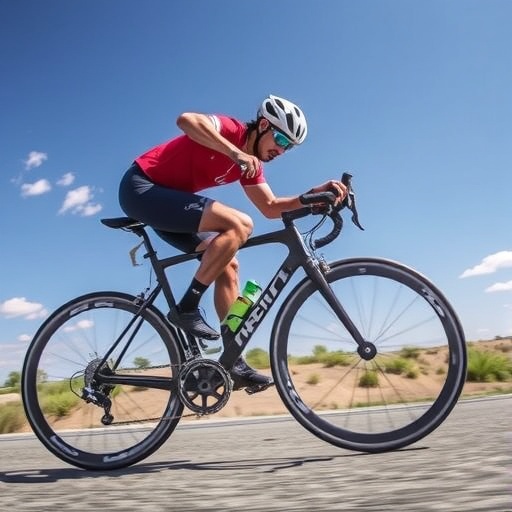In the ever-evolving field of sports science, bicycle racing has always been a domain where minimal adjustments can lead to significant performance gains. One area that has not received extensive attention until recently is the effect of arm positioning on aerodynamic drag. A pioneering study by Maddocks and Walker has shed light on this critical aspect of cycling aerodynamics, providing insights that could revolutionize the way athletes prepare for time trials. With aerodynamic drag being a critical factor that can influence race outcomes, optimizing every component of a cyclist’s position is paramount.
The researchers approached their investigation with an eye on performance metrics that matter most: speed and efficiency. Aerodynamic drag is a phenomenon that essentially accounts for the air resistance encountered by a cyclist as they speed down the road. A deeper understanding of how each element of a cyclist’s positioning interacts with the airflow can transform training regimens and ultimately enhance overall performance. Cyclists often spend significant time and resources refining their bike setups and clothing but may not fully appreciate how something as simple as arm positioning can impact their racing times.
During their study, Maddocks and Walker delved into various arm positions and their corresponding impacts on aerodynamic drag. Utilizing advanced wind tunnel testing, they were able to simulate real-world cycling conditions. This method allowed them to gather precise data on how different stances influenced the cyclist’s overall drag coefficient. The results were illuminating. Minor adjustments to arm positioning resulted in notable changes in airflow patterns and, consequently, drag. Understanding these nuances can offer cyclists a competitive edge.
In the context of time trials, where every second counts, even slight reductions in drag can lead to meaningful improvements in performance. For competitive cyclists, the implications of this study are vast. For instance, the research suggests that cyclists should explore varying their arm positions based not only on comfort but also on how those positions affect their aerodynamic profile. By meticulously experimenting with their stances, athletes might discover ideal positions that lead to improved drag coefficients, enabling them to achieve faster speeds with less effort.
The significance of this research extends beyond personal best times. It has broader implications for bicycle design and athletic apparel as well. Manufacturers could take these findings into account when designing bikes and clothing meant for optimal performance. If specific arm positions result in decreased drag, bike manufacturers could potentially create designs that encourage those positions or offer cycling gear that aids in maintaining them. This synergy between research and practical application can foster innovations in the cycling industry.
As Maddocks and Walker emphasize, the outcome of their research appears to challenge traditional assumptions in the world of competitive cycling. For years, many cyclists have relied on standard positioning as prescribed by coaches and manufacturers. This study suggests it may be time to rethink those conventions. By embracing evidence-based approaches, athletes can tailor their strategies to achieve optimal performance, maneuvering past their competitors while also enhancing their stamina and endurance.
Furthermore, this research opens the door to future investigations that could explore additional factors influencing aerodynamic performance in cycling. Following the groundwork laid by Maddocks and Walker, subsequent studies may delve into how elements such as torso position, head angle, and even leg placement interconnect with arm positioning to create an understanding of the optimal cycling posture. A thorough examination of these variables can lead to a nuanced framework for cyclists to enhance their training processes.
One compelling aspect of the research is the potential for practical applications not just for elite athletes but for everyday cyclists as well. Education about the impact of arm positioning could prove beneficial even to leisure riders. Understanding that their body position affects drag can inspire both recreational and competitive cyclists to adopt better practices while riding. This insight has the potential to widen participation in cycling by making the sport more accessible and enjoyable through greater understanding and application of aerodynamics.
The study’s findings also highlight an important intersection between theoretical knowledge and applied practices in sports. As the world of sports science becomes increasingly data-driven, the capacity for rigorous analysis will only enhance performance across athletic disciplines. The methodologies and insights presented by Maddocks and Walker can serve as a model not only for future research in cycling but also for other sports that require precision and efficiency. Through collaborative efforts across disciplines, the potential for advancing human performance knows no bounds.
In conclusion, the investigation into the effect of arm positioning on aerodynamic drag by Maddocks and Walker is a crucial contribution to the field of cycling science. As competitive cycling grows ever more intense, studies such as this can make the difference between winning and losing. The implications reach far beyond individual cyclists, impacting entire teams and equipment manufacturers. As athletes and coaches adopt the findings of this research, the future of cycling could witness a wave of innovation driven by improved aerodynamics. The race against time is on, and those who heed the lessons from this study may find themselves crossing the finish line ahead of the competition.
Through this research, a new chapter in sports science is unfolding, and it invites all cyclists—be they elite competitors or recreational riders—to embrace the pursuit of knowledge in their quest for speed. As more studies like this emerge, the cycling community is poised to reap the benefits of enhanced understanding, ultimately leading to a stronger and more informed cycling culture.
Subject of Research: Aerodynamic drag and arm positioning in cycling
Article Title: Effect of arm position on the aerodynamic drag of an individual time trial position
Article References:
Maddocks, P., Walker, A.D. Effect of arm position on the aerodynamic drag of an individual time trial position.
Sports Eng 28, 11 (2025). https://doi.org/10.1007/s12283-025-00495-7
Image Credits: AI Generated
DOI:
Keywords: Aerodynamics, Cycling, Time Trial, Arm Position, Performance Optimization




